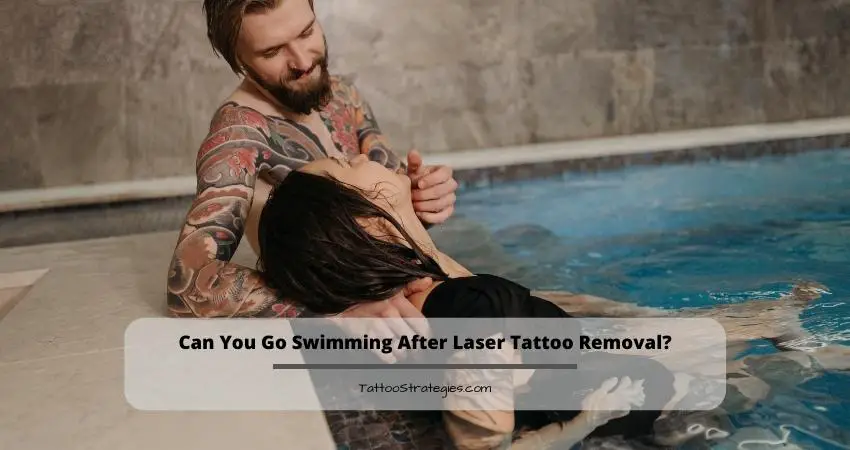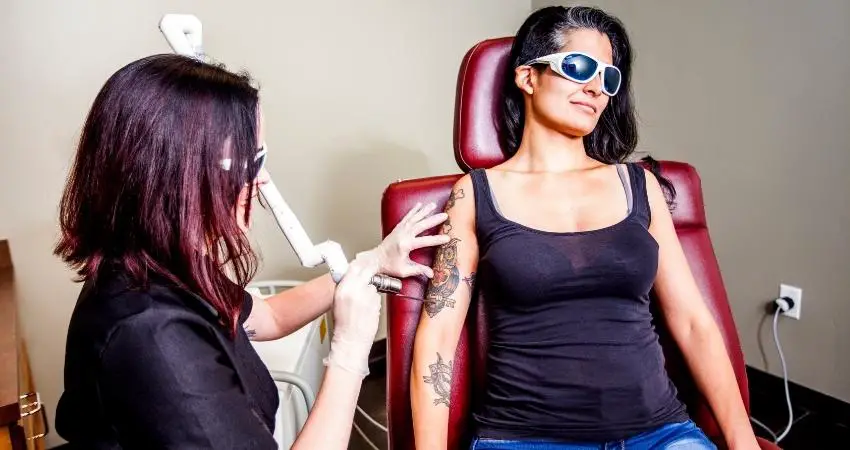Can You Go Swimming After Laser Tattoo Removal?
Inquiries concerning swimming during tattoo removal are occasionally made at the clinic. Swimming is safe to do before beginning laser tattoo removal. Therefore, the query is can you go swimming after laser tattoo removal?
Before going swimming, you should wait three to four days following each laser tattoo removal treatment. Swimming is not recommended immediately after laser tattoo removal since the skin in the treated area is still mending from the laser.
The solution to whether you can go swimming after laser tattoo removal has been examined from every conceivable perspective. Continue reading to find out more.

Swimming Before and After Laser Tattoo Removal
Swimming is absolutely safe before beginning laser tattoo removal treatments; swimming after treatments raises safety concerns. For three to four days after each laser tattoo removal session, swimming should be avoided.
TLDR; it is not advised to go swimming right after getting a tattoo removed with a laser.
You should avoid immersing the treated area in any water that could be too hot or polluted for the first several days following each treatment.
Hot tubs, swimming pools, lakes, rivers, and seas should all be avoided as they may carry infectious microorganisms. Even an overly hot shower or bath water is not recommended since it might irritate the region that has been treated.
However, don’t worry too much if you accidentally come in contact with unclean water; simply make sure to completely wash the area with soap and clean water, and if necessary, apply ointment and bandages.
Make sure to call a doctor if you discover an infection-like symptom in the region.
The safest course of action for the first few days following your sessions is to stay away from seas and public pools as much as you can. Anything could be circling there; you never know.
This will reduce the likelihood that your tattoo will get inflamed or infected.

Laser Tattoo Removal Aftercare Instructions
Some aftercare tips will save you from any unwanted situations. Make sure you take them seriously (chuckle!).
Steps to Follow
Now that we know what aftercare for laser tattoo removal entails, let’s look at it more closely. By following these steps, you will accelerate the healing process after laser tattoo removal.
Step 1: Keep the removal area clean
For the first three days, keep the tattoo removal area neat and dry.
Step 2: Use an ointment
After tattoo removal, apply an ointment such as hydrocortisone cream to minimize inflammation. Damaged skin cells can also be repaired by vitamin E oil.
Additionally, these ointments might lessen itching, which will prevent you from wanting to itch the region that is hurt.
Step 3: Keep the area moisturized
Use a sterile lancet to make a tiny hole at the base of any blisters that grow larger than a dime so they may drain. Keep the area hydrated and hasten the healing process by using an over-the-counter antibacterial cream or ointment since the wound is now deemed to be open.
To maintain the healthiest possible skin condition during the removal procedure, adhere to these aftercare guidelines for laser tattoo removal.
For more detailed advice on tattoo removal aftercare, see your tattoo removal professional. Excellent skin care after laser tattoo removal will expedite healing and produce the greatest outcomes!
How Long After Tattoo Removal Can You Swim?
The treated region should not be submerged in hot or potentially contaminated water until the tattoo has healed, just like when receiving a tattoo.
We suggest avoiding baths, hot tubs, pools, oceans, lakes, rivers, etc., where the tattoo is submerged until any redness or blisters have healed. We advise avoiding submersion to prevent contact with any potential sources of infection for your recently treated tattoo.
It’s advisable to wait three to five days for the ink to cure before bathing in a hot tub or any other body of water, as we previously advised.

Undoubtedly, swimming should be avoided until the treated region has recovered. If, after three to five days, your tattoo is still red, itchy, or blistering. Don’t worry if you unintentionally fall into the water.
Just gently and completely cleanse the area with clean water and mild soap. then follow the regular aftercare procedures.
It’s important to note that keeping the treated area out of the sun is equally important.
You can bandage the region or don a cover sleeve to avoid direct sunlight.
Speeding Up the Tattoo Removal Healing Process
Starting with the initial session, it’s essential to maintain optimum health for your body and skin during that period. Following your visit to the clinic, you may use these methods to jump-start the healing process for your laser tattoo removal.
- The key to maintaining a good immune system is to keep the body hydrated.
- Dehydration brought on by excessive alcohol use might hinder the recovery process. If at all possible, avoid drinking.
- Don’t smoke. To eliminate the poisons from smoking, your immune system must exert more effort. Smoking prevents your body from efficiently repairing the skin.
- The blood flows more while you exercise. Your skin’s ink particles are broken down by increased blood flow. Thus, it’s best to take a break from your workout sessions after removing tattoo with laser treatment. However, after the skin scabs have grown back, exercise might speed up the tattoo removal procedure.
Two additional things are categorically prohibited if you wish to get quicker and more fruitful outcomes.
Avoid Overexposure to The Sun
You must keep the treated area away from the sun after laser tattoo removal therapy.
If you receive a sunburn in between treatments, you must postpone your next appointment until your skin returns to normal color. Delaying treatments will lengthen the procedure and make it more difficult to observe permanent benefits.
Sunburns aren’t the only thing that hinders the healing process; any quantity of tanning can do the same. If you intend to spend time in the sun, wear sunscreen and protect your skin with clothing or bandages.
Avoid Picking at Scabs or Popping Blisters
The normal side effects of the healing process include blistering and scabbing. You’ll want to pick and snap at your skin is strong. Don’t do this in any way. Opening the wound prolongs the healing process and raises the danger of infection.
Additionally, stay away from shaving any areas of skin that have blisters or scabs on them.
When using a razor, you run the risk of accidentally opening the wound. Allow blisters to drain naturally and scabs to come off naturally for the greatest results.
Frequently Asked Questions
What Negative Effects Might Tattoo Removal Have?
Although infections are uncommon, you should be aware of the warning symptoms just in case. A rash, chills, and drainage from the treated region are symptoms of tattoo removal infection. Notify your removal professional if you detect any of these indicators.
